Doughboys 1930 Pictures of Fashion From the Decade 1930

The most feature Northward American fashion trend from the 1930s to 1945 was attention at the shoulder, with butterfly sleeves and banjo sleeves, and exaggerated shoulder pads for both men and women by the 1940s. The period also saw the kickoff widespread use of man-made fibers, especially rayon for dresses and viscose for linings and lingerie, and constructed nylon stockings. The zipper became widely used. These essentially U.South. developments were echoed, in varying degrees, in U.k. and Europe. Suntans (called at the time "sunburns") became fashionable in the early 1930s, along with travel to the resorts along the Mediterranean, in the Bahamas, and on the east coast of Florida where one tin acquire a tan, leading to new categories of clothes: white dinner jackets for men and embankment pajamas, halter tops, and bare midriffs for women.[ane] [2]
Way trendsetters in the period included Edward VIII and his companion Wallis Simpson, socialites similar Nicolas de Gunzburg, Daisy Fellowes and Mona von Bismarck and such Hollywood movie stars equally Fred Astaire, Carole Lombard and Joan Crawford.
Womenswear [edit]
1930s [edit]

Width at the shoulders was achieved by many means. In Dorothy Gish's outfit of 1932, the width is in the sleeve cap, which is pleated into the armscye.

Classic fashion in the Thirties in Europe (Republic of hungary 1939).
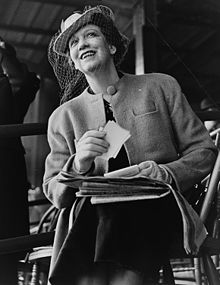
Elizabeth Arden'south coat features broad, rounded shoulders cut in one piece with the yoke, 1939.

Overview [edit]
The lighthearted, forward-looking attitude and fashions of the late 1920s lingered through most of 1930,[3] merely past the end of that twelvemonth the furnishings of the Great Depression began to impact the public, and a more than conservative approach to fashion displaced that of the 1920s. For women, skirts became longer and the waist-line was returned up to its normal position. Other aspects of fashion from the 1920s took longer to stage out. Cloche hats remained popular until near 1933 while curt hair remained pop for many women until late in the 1930s and even in the early 1940s. The Great Low took its toll on the 1930s womenswear due to World War II which dates from 1939 to 1945. This greatly afflicted the fashion of how women dressed during the 1940s era. According to Shrimpton "Committed to ensuring the fair distribution of scarce but essential resources, namely food, clothing, and article of furniture, the regime introduced a comprehensive rationing scheme based on allocation of coupons - a organisation deriving, ironically, from the German rationing plan devised in Nov 1930."[4]
Because of the economic crash, designers were forced to slash prices for wear in lodge to continue their business organization afloat, especially those working in couture houses. Designers were besides forced to use cheaper fabric and materials, and dress patterns as well grew in popularity as many women knew how to sew. Hence, vesture was made more accessible, and there was also a continuation of mass production, which was ascent in popularity since the 1920s. The 1930s immune women from all classes and socio backgrounds to exist fashionable, regardless of wealth. With prices slashes on types of fabrics utilized for designing, new inventions such as the zero fabricated garments quicker and cheaper to make. This was also influenced past the ascension in women inbound the workforce alongside the rise of the concern girl, every bit they still were able to beget to dress well and stay in way. Daywear also had to be functional, but it never lost its touch on of elegance or femininity, as the dresses would still naturally highlight the female or womanly shape with cinched waistlines, skirts fitted to the hip and fullness added to the hem with flared gores or pleats. Frilled rayon blouses too went with the cinched waist.[5]
Because clothes were rationed and cloth was scarcer, the hem lines of dresses rose to knee length. The main sort of dress in the 1940s included features such every bit an 60 minutes glass shape figure, broad shoulders, nipped in high waist tops and A line skirts that came down to just at the knee. Many unlike celebrities who embraced this blazon of mode such equally Joan Crawford, Ginger Rogers, Barbara Stanwyck, and Ava Gardner. Fifty-fifty though daywear dresses were influenced by the war, evening dresses remained glamorous. Women'due south undergarments became the soul of fashion in the 1940s[6] considering it maintained the disquisitional hourglass shape with smooth lines. Apparel became utilitarian. Pants or trousers were considered a menswear detail only until the 1940s.[6] Women working in factories start wore men's pants but over fourth dimension, factories began to brand pants for women out of fabric such as cotton, denim, or wool. Coats were long and downwards to the knee for warmth.
Major manner magazines at the time including Vogue continued to cater to the fashionable and wealthy women of the 1930s to continue reporting and reflecting the virtually pop trends in that time flow, despite the impact the economic crash had on them. The wealthiest nonetheless managed to afford and go on up with the most high-end or the most coveted designs and maintain their lifestyle.
Mode and the movies [edit]

Indian saree made from chiffon fabric, inspired by the evening dresses of Hollywood starlets.
Throughout the 1930s and early 1940s, a 2nd influence vied with Paris couturiers as a wellspring for ideas: the American cinema.[7] As Hollywood movies gained their popularities, general public idolized film stars as their role models. Paris-based fashion houses were losing their ability and influences in near major way trends during these years. Many American and European moviegoers were fascinated by and got interested in overall fashion including dress and hairstyles of movie stars which led to diverse style trends.[8] After the pic Tarzan, animal prints became popular. On the other hand, different styles such every bit bias-cut, satin, Jean Harlow-fashion evening dresses and the casual look of Katharine Hepburn besides became famous.[9] Paris designers such as Elsa Schiaparelli and Lucien Lelong acknowledged the touch of film costumes on their piece of work. LeLong said "We, the couturiers, tin can no longer live without the cinema whatsoever more than than the cinema can alive without us. We approve each others' instinct.[10]
The 1890s leg-o-mutton sleeves designed by Walter Plunkett for Irene Dunne in 1931's Cimarron helped to launch the broad-shouldered look,[11] and Adrian's piddling velvet chapeau worn tipped over one eye by Greta Garbo in Romance (1930) became the "Empress Eugénie hat ... Universally copied in a wide price range, it influenced how women wore their hats for the rest of the decade."[11] During late 1920s to early 1940s, Gilbert Adrian was the caput of the costume section at Metro-Goldwyn-Mayer, the most prestigious and famous Hollywood movie studio. He produced numerous signature styles for the summit actresses of the flow, too as countless manner fads during those times. One of his popular dresses was gingham dress, a cotton wool dress with a checked or striped blueprint, that he made for Judy Garland for the movie The Wizard of Oz in 1939, and for Katharine Hepburn for the picture The Philadelphia Story in 1940.[8] Movie costumes were covered not only in film fan magazines, but in influential fashion magazines such equally Women'southward Wear Daily, Harper's Boutique, and Vogue.
Adrian'south puff-sleeved gown for Joan Crawford Letty Lynton was copied by Macy's in 1932 and sold over 500,000 copies nationwide.[12] The dress was appraised as ane of the most influential pieces in the era's fashion, inspiring numerous designers to showcase similar styles in their own work.[xiii] Ane of Crawford'south widely influential pieces was a white organdy dress with ruffle adornments. With the utilize of shoulder pads, the dress made the movement freer, emphasizing the back by removing adornments previously popularized in the 1920s.[14]
I of the about stylistically influential films of the 1930s was 1939's Gone with the Wind. The dresses in the picture were designed with simplified adornments and a mixture of different monotone hues equally opposed to using a varied colour palette. This was considered to be Plunkett's intentional design to utilize modernism, the emerging aesthetic of the 1930s. Plunkett received praise for producing costumes that fairly harmonized the era of the movie with the aesthetic sense of the late 1930s. The costumes brought back the Neo-Victorian way, too as strong use of symbolic color.[15] It inspired the Princess Ballgown, a Victorian style wearing apparel reduced to total A line skirts with petticoats underneath for fullness.[6] It was the about popular style for teens going to prom.[6] Plunkett'southward "barbecue dress" for Vivien Leigh as Scarlett O'Hara was the nearly widely copied dress after the Duchess of Windsor'southward wedding costume, and Vogue credited the "Scarlett O'Hara" look with bringing total skirts worn over crinolines back into nuptials fashion after a decade of sleek, figure-hugging styles.[11]
Lana Turner's 1937 motion picture They Won't Forget made her the first Sweater girl, an breezy look for young women relying on large breasts pushed upwardly and out by bras, which connected to be influential into the 1950s, and was arguably the first major style of youth fashion.
Travis Banton gained his fame by, after working at a couture house in New York, designing costumes for Marlene Dietrich as a caput designer of Paramount. His fashion was softer and more alluring than Adrian's, embodying femininity past his sense of balance with the use of Vionnet's bias-cutting, and was known for refined concepts of uncomplicated lines and classic styles. Many famous motion picture stars during the 1930s such as Magdalene Dietrich and Mae W at Paramount became the models of wit, intellect and beauty through Banton's elegant costumes. The costumes he made for Dietrich for diverse movies such as Shanghai Express 1932, and The Cherry-red Empress 1934 portray her sharp regality.[13]
Retail clothing and accessories inspired by the menses costumes of Adrian, Plunkett, Travis Banton, Howard Greer, and others influenced what women wore until war-time restrictions on fabric stopped the menstruum of lavish costumes from Hollywood.[11]
Difficult chic and feminine flutters [edit]

Jean Patou, who had beginning raised hemlines to 18" off the floor with his "flapper" dresses of 1924, had begun lowering them again in 1927, using Vionnet's handkerchief hemline to disguise the change. By 1930, longer skirts and natural waists were shown everywhere.[16]
Merely it is Schiaparelli who is credited with "changing the outline of fashion from soft to hard, from vague to definite."[16] She introduced the zipper, synthetic fabrics, elementary suits with bold color accents, tailored evening gowns with matching jackets, wide shoulders, and the color shocking pink to the manner globe. By 1933, the trend toward wide shoulders and narrow waists had eclipsed the emphasis on the hips of the later 1920s.[16] Wide shoulders would remain a staple of fashion until after World War Ii.
In contrast with the hard chic worn by the "international set".[sixteen] designers such as Britain's Norman Hartnell made soft, pretty dresses with fluttering or puffed sleeves and loose dogie-length skirts suited to a feminine figure. His "white mourning"[17] wardrobe for the new Queen Elizabeth'due south 1938 state visit to Paris started a brief rage for all-white clothing.[18]
Feminine curves were highlighted in the 1930s through the use of the bias-cut. Madeleine Vionnet was an early innovator of the bias-cut, using it to create clinging dresses that draped over the body's contours.[xix]

Advertisement for women's mode at McWhirters section store, Brisbane, Australia, 1941
Through the mid-1930s, the natural waistline was often accompanied by emphasis on an empire line. Short bolero jackets, capelets, and dresses cutting with fitted midriffs or seams below the bust increased the focus on breadth at the shoulder. Past the tardily 1930s, accent was moving to the back, with halter necklines and high-necked but backless evening gowns with sleeves.[2] [16] Evening gowns with matching jackets were worn to the theatre, nightclubs, and elegant restaurants.
Skirts remained at mid-dogie length for 24-hour interval, merely the terminate of the 1930s Paris designers were showing fuller skirts reaching just below the articulatio genus;[20] this practical length (without the wasteful fullness) would remain in manner for day dresses through the war years.
Other notable fashion trends in this catamenia include the introduction of the ensemble (matching dresses or skirts and coats) and the handkerchief brim, which had many panels, insets, pleats or gathers. The clutch coat was fashionable in this period also; information technology had to exist held shut as there was no fastening. By 1945, adolescents began wearing loose, poncho-similar sweaters called sloppy joes. Full, gathered skirts, known equally the dirndl skirt, became popular around 1945.[21]

Accessories were vital components of an outfit, this 1943 black concern arrange was accessorized with a halo hat, black gloves and pink clutch bag
Accessories [edit]
Gloves were "enormously important" in this period.[xviii] They were a blazon of accessory that came to exist seen as more of a condolement rather than for way. The elaborate trim was removed and was replaced by obviously gloves. Evening gowns were accompanied by elbow length gloves, and twenty-four hour period costumes were worn with short or opera-length gloves of fabric or leather.
Manufacturers and retailers introduced analogous ensembles of hat, gloves and shoes, or gloves and scarf, or hat and bag, oftentimes in striking colours.[18] For jump 1936, Chicago's Marshall Field's department store offered a black hat past Lilly Daché trimmed with an antelope leather bow in "Pernod green, apple tree blossom pink, mimosa yellow or carnation chroma" and suggested a pocketbook to match the bow.[22]
When state of war broke out in 1939, many women purchased handbags with a respirator pouch due to fear of poison gas attacks.[23]
Sportswear [edit]
During the mid to tardily 1930s, swimsuits became more revealing than those of the 1920s, and oftentimes featured lower necklines and no sleeves. These were made from nylon and rayon instead of the traditional wool, and no longer included a short modesty brim.[24] Experimental swimsuits made from spruce wood veneer were a fad in the early 1930s, but did not grab on amongst the mainstream.[25]
Marriage of Wallis Simpson and Male monarch Edward VIII (from January 1936 until his abdication) [edit]
Notable American socialite was Wallis Simpson and her marriage to Prince Edward was likewise seen equally influential trendsetters during the 1930s period of mode. Their matrimony was historical, been chosen "The Greatest Love Story of the 20th Century" past some, due to the fact that Prince Edward was royalty and in line for the throne. All the same, his love thing with Wallis Simpson is what attracted attention and made headlines.
Simpson was non merely a socialite, but she was American and a divorcee, both of which were bargain breakers for the imperial family at the time. Every bit Prince Edward found he could non marry Simpson on these circumstances, he did the unthinkable past giving up the throne to ally her. As the two wed in 1937, their marriage marked a more than progressive mindset that people slowly began to adopt, as people already wanted to ditch one-time traditions and trade it for new ones, especially for those in the purple family.
Their wedding and marriage was well chronicled by Vogue, including a spread of Wallis Simpson before her wedding day, captured by iconic fashion lensman, Cecil Beaton, which included the iconic Lobster wearing apparel by Elsa Schiaparelli, which included a paw-painted lobster by Salvador Dalí, a significant surrealist artist and painter in the 1930s.[5]
State of war years [edit]
Wartime austerity led to restrictions on the number of new clothes that people bought and the corporeality of textile that wear manufacturers could use. Women working on war service adopted trousers as a practical necessity. The United States government requisitioned all silk supplies, forcing the hosiery industry to completely switch to nylon. In March 1942 the government then requisitioned all nylon for parachutes and other war uses, leaving only the unpopular cotton and rayon stockings. The industry feared that not wearing stockings would get a fad, and advised stores to increase hosiery advertizement.[26] When nylon stockings reappeared in the shops in that location were "nylon riots" as customers fought over the kickoff deliveries.[27]
In U.k., clothing was strictly rationed, with a system of "points", and the Lath of Trade issued regulations for "Utility Dress" in 1941.[18] In America the War Production Lath issued its Regulation L85 on March eight, 1942, specifying restrictions for every item of women'south wearable.[28] Because the military machine used so much green and brown dye, manufacturers used more red dye in clothing.[26] Easily laddered stockings were a item concern in Britain; women were forced to either paint them on (including the dorsum seam) or to join the WRNS, who continued to outcome them, in a cunning aid to recruitment. Later in the war, American soldiers became a source of the new nylon stockings.
Nigh women wore skirts at or near knee-length, with simply-cut blouses or shirts and foursquare-shouldered jackets. Popular magazines and pattern companies brash women on how to remake men'due south suits into smart outfits, since the men were in uniform and the textile would otherwise sit down unused. Eisenhower jackets became pop in this period. Influenced past the military, these jackets were bloused at the chest and fitted at the waist with a belt.[21] The combination of bully blouses and sensibly tailored suits became the distinctive attire of the working woman, college girl, and immature society matron.[29]
The shirtwaist dress, an all-purpose garment, also emerged during the 1930s. The shirtwaist wearing apparel was worn for all occasions, besides those that were extremely formal, and were modest in design. The dress could either have long or short sleeves, a minor neckline and brim that savage below the articulatio genus. The bosom was rounded merely not particularly emphasized and the waistline was oft belted in its normal position. Pockets were both functional and used for ornament and were accompanied past buttons down the front end, around the sides or up the dorsum of the dress. These dresses often were accompanied past coordination coats, which were made out of contrasting fabric but lined with the dress fabric. The jacket was oftentimes constructed in a indigestible fashion and had wide lapels, wide shoulders and numerous pockets. The dress and coat combination created an overall effect of sensibility, modesty and girl adjacent door lifestyle that assorted the very popular, second-skin like style of the bias-cutting evening gown.[29]
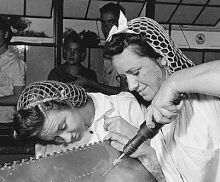
Women wearing snoods in a factory
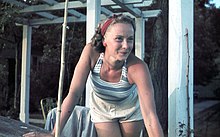
Women's fashion in vacation in Lake Balaton in Hungary (1939).
Headwear [edit]

Woman wearing a turban during wartime with all the fashionable accessories.
The 1940s was a period marked past iconic headwear. Because of the war, current European manner was no longer available to women in the U.s.a.. In 1941, hatmakers failed to popularize Chinese and American Indian-based designs, causing i milliner to lament "How unlike when Paris was the fountainhead of fashion". As with hosiery hatmakers feared that bareheadness would become pop, and introduced new designs such as "Winged Victory Turbans" and "Commando Caps" in "Victory Gold".[26] American designers, who were often disregarded, became more popular every bit American women began to wearable their designs. American designers of ready-to-wear contributed in other ways too. They made improvements to sizing standards and began to utilize cobweb content and intendance labels in clothing.[30] Hats were ane of the few pieces of wearable that was not rationed during WWII, therefore at that place was a lot of attending paid to these headpieces. Styles ranged from turbans to harbinger hats.[31] The snood was an important accessory to a woman working in the manufacturing plant. Snoods were fashionable and functional at the same time, they enabled manufactory women who were wearing pants and jumpsuits to still await feminine. Snoods pulled hair out of the confront by containing information technology all at the back of the head in a hanging net. With all the long hair hanging in the internet, the front of the pilus was left out and could be curled and styled to glamourize the factory uniforms. Other pop headpieces were variations of headscarves, such as the bandana Rosie the Riveter is pictured wearing in the recruitment posters. Another variation of the headscarf was simply tying a square scarf folded in half under the chin. Afterward in the 1950s and 60s these headscarves became highly glamorized past celebrities similar Audrey Hepburn, Brigitte Bardot, and Jacqueline Kennedy. This glamorized look came from women in the 1940s who wore headscarves over their victory rolls in gild to brand their simple clothes expect dressed up. Draped turbans – sometimes fashioned from headscarves – also made an advent in fashion, representing the working adult female of the menses. These were worn by women of all classes.This type of headwear could exist glamorous or practical. Turbans were the most functional for the working woman because she was able to take all her hair out of her face and skip washing her hair by covering it with the turban. Both turbans and headscarves were useful for hiding curlers so when a woman got off work all she had to practice was have out her curlers and her pilus would be prepare for a night out.[32] All these alternative options to hats were popular, non only for function and glamour, just also considering the look could be achieved quite inexpensively.
Swimwear [edit]
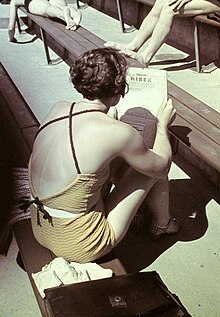
Adult female wearing a swimsuit in swimming puddle in Republic of hungary in 1938.
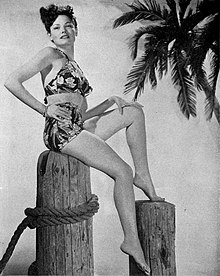
Typical 1945 ii-piece swimsuit worn by Gene Tierney
An of import style that became popular due to the state of war was the ii-slice swimsuit which later led to the Bikini. In 1942, the War Production Lath passed a constabulary chosen the 50-85 which put restrictions on wearable production.[33] For swimwear companies the L-85 meant they had to utilize 10 percent less fabric in all their designs, as a consequence swimsuits became smaller. Swimsuits had been becoming more minimal for a while but in 1944 Tina Leser debuted one of the first 2-slice swimsuits. Even though the bottoms were high waisted, cut depression on the legs, and paired with a modest bandeau, Lesers' two piece was even so considered a daring style for the era. According to Sarah Kennedy, author of The Swimsuit: A History of Twentieth-Century Way, different the bikini the two-piece was created out of necessity and was not meant to exist shocking. Patently there was an unspoken rule that bellybuttons must never show which accounts for the high waisted bottoms.[34] Despite it being scandalous to some, the two-piece was eventually accepted considering there really wasn't another option. The L-85 did non only make swimsuits smaller, but it besides pushed designers to go more creative with their designs, this led to suits that accentuated and drew attention to women's bodies. This was washed by putting boning in the swimwear. Ii years after Leser debuted 1 of the first two-pieces, the bikini was invented in 1946 by a French engineer named Louis Réard. It was plainly named after the Bikini Atoll, which was the site of a nuclear flop examination in 1946, because Réard hoped its touch on would exist explosive in the fashion earth.[35] The bikini was fifty-fifty more daring than the ii-piece, thus it did not become popular until 1953 when Brigitte Bardot was photographed in i at the Cannes Motion picture Festival. Although the bikini did become pop in Europe in 1953 it did not become popular in the United states of america until the 1960s.
Way gallery [edit]
1930–1935 [edit]
-

1 - 1930
-
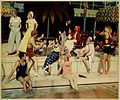
two - 1932
-

three - 1932
-

four - 1933
-

5 – 1933
-

half dozen – 1933
-

vii – 1934
-

eight – 1934
-

9 - 1934
-

10 – 1935
-

11 – 1935
- Newspaper advertisement for women's dresses, Paris Dress Shoppe, Allentown PA, 1930.
- A collection of swimwear, Ladies Home Periodical, 1932.
- Dutch actress Cissy van Bennekom and model Eva Waldschmidt, 1932.
- Models wearing evening dresses by Jeanne Lanvin, 1933.
- Actress Mae West wearing an elaborate nightgown in She Done Him Wrong, 1933.
- Portrait of Nan Wood Graham past Grant Wood, wearing a polka dot blouse and Marcel wave hair, 1933
- Outlaw Bonnie Parker continuing in front of a Ford Model 18, 1934.
- Daughter in Dallas, Texas wears a sweater and mid-calf length brim with pleats, 1934.
- Singer Annette Hanshaw models an evening dress designed by Gladys Parker, 1934
- Immature woman wearing a long, form-plumbing equipment dress with puffed sleeves, 1935.
- Actress Elisabeth Bergner wears a fashionably tilted hat and a leopard fur coat, 1935.
1936–1939 [edit]
-

1 – 1936
-

2 – 1936
-

iii - 1936
-

4 – 1936
-

5 - 1937
-

6-1937
-

7- 1938
-

viii-1938
-

9-1939
-

10-1939
- Young woman wears her hair in curt, hard curls framing her face, but smooth at the crown to adjust her small lid, 1936.
- Immature woman wears a printed dress fitted through the midriff with short puffed sleeves, Minnesota, 1936.
- Carole Lombard in a gown Travis Banton designed for her personal wardrobe, 1936
- Author Alfonsina Storni at the beach resort city of Mar del Plata, 1936.
- Art exhibit of artist Roy Parkinson and his pupils, Brisbane, Queensland, Australia, 1937.
- Window shoppers outside Simpsons department shop in Toronto, Ontario, Canada, 1937.
- Portrait of writer Zora Neale Hurston, 1938
- Center anile couple, U.s., July, 1938
- Plastic face protection from snowstorms. Canada, Montreal, 1939
- "Cyclone" evening dress by Jeanne Lanvin, 1939.
1940–1945 [edit]
-

1 – 1941
-

2 – 1941
-

three – 1941
-

4 – 1942
-

5 – 1942
-

half dozen – 1943
-

7 – 1943
-

8 – 1943
-

9 – 1943
-

10 – 1944
-

eleven – 1944
-

12 – 1945
- Sportswear of 1941 featured square shoulders and flared shorts.
- Actress Lana Turner examines cotton stockings, wearing a smart knee-length adjust with square shoulders, in this Farm Security Administration photo of 1941
- Actress Rita Hayworth in a pink and silver lamé evening gown by Howard Greer, 1941.
- Clerk at North American Aviation in California wears a pompadour hairstyle with back hair bars in a floral snood tied with a bow, 1942.
- Girls wearing swimsuits in Republic of hungary, 1942.
- Women employees of the Aluminum Co. of Kingston, Ontario wear knee joint-length skirts with blouses or sweaters (often with a string of graduated pearls), 1943.
- Women's fashion in Europe (Republic of hungary, 1943).
- Singer Peggy Lee wears a pompadour hairstyle and an evening gown with a "sweetheart" neckline in the film Stage Door Bottle, 1943.
- Typical women'south and kids' fashion in Europe during the Forties, Hungary in 1943, during the 2d Globe State of war.
- Writer Lillian Smith wears a dark suit with an open-collared blouse, 1944.
- Bathing suits worn by members of the WACs in North Africa, 1944.
- Argentine extra Mirtha Legrand with director Luis Saslavsky, 1945.
Menswear [edit]

Conductor Leonard Bernstein in sportswear of 1945: open-collared shirt, striped blazer, and broad-legged pleated slacks

Men's neckties oft had bold, geometric patterns equally can exist seen in this photograph taken in 1944
Overview [edit]
For men, the most noticeable consequence of the general sobering associated with the Great Low was that the range of colors became more subdued. The bright colors popular in the 1920s fell out of fashion.
Suits [edit]
By the early 1930s, the "curtain cut" or "London Drape" arrange championed by Frederick Scholte, tailor to the Prince of Wales, was taking the world of men's fashion by storm. The new suit was softer and more flexible in construction than the suits of the previous generation; extra fabric in the shoulder and armscye, light padding, a slightly nipped waist, and fuller sleeves tapered at the wrist resulted in a cut with flattering folds or drapes front and back that enhanced a homo's effigy. The directly leg wide-trousers (the standard size was 23 inches at the cuff) that men had worn in the 1920s also became tapered at the bottom for the commencement time effectually 1935. The new suit was adopted enthusiastically by Hollywood stars including Fred Astaire, Cary Grant, and Gary Cooper, who became the new fashion trendsetters after the Prince's abdication and exile. Past the early 1940s, Hollywood tailors had exaggerated the drape to the signal of caricature, outfitting moving-picture show noir mobsters and private eyes in suits with heavily padded chests, enormous shoulders, and wide flowing trousers. Musicians and other fashion experimenters adopted the most extreme form of the drapery, the zoot adapt, with very loftier waists, pegged trousers, and long coats.[36] [37]
Formal wear [edit]
In the early 1930s, new forms of summertime evening clothes were introduced as advisable for the popular seaside resorts. The waist-length white mess jacket, worn with a cummerbund rather than a waistcoat, was modeled after formal clothing of British officers in tropical climates. This was followed by a white dinner jacket, single or double-breasted. Both white jackets were worn with black bow ties and black trousers trimmed with braid down the side seams.
Sportswear [edit]
By 1933, knickerbockers and plus-fours, which had been commonly worn as sports-clothes in the 1920s had lost favor to casual trousers among the fashionable. In Britain and South Africa, brightly striped blazers in red, white and blue were often worn in the summer both every bit informal wear, and for sports such as tennis, rowing or cricket. This continued until wartime rationing rendered the distinctive material unobtainable.[38]
Accessories [edit]
The near common hat of this period was the fedora, often worn tipped down over 1 centre at a rakish angle. The more conservative Homburg besides remained pop, especially among older people and fifty-fifty began to be worn with semi-formal evening dress in place of the tophat, which in turn became bars to article of clothing with formal. Neckties were wide, and bold geometric designs were popular, including stripes, and quadrilateral designs.
Wartime restrictions [edit]
Many things afflicted the way of wearing apparel that people wore. Austerity also affected men'due south noncombatant clothes during the state of war years. The British "Utility Adapt" and American "Victory Adjust" were both made of wool-synthetic blend yarns, without pleats, cuffs (plow-ups), sleeve buttons or patch pockets; jackets were shorter, trousers were narrower, and double-breasted suits were made without vests (waistcoats).[1] Men who were not in uniform could, of course, go on to wear pre-war suits they already owned, and many did so.
Style gallery 1930s [edit]
-

1 – 1930
-

2 – 1934
-

3 - 1937
-
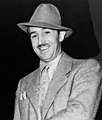
iv – 1938
- Golfing attire of 1930, worn by Baby Ruth and erstwhile New York governor Al Smith - State Archive of Florida.
- Double-breasted suits take pocket flaps and functional buttonholes in both lapels. President Franklin D. Roosevelt, 1934.
- Photo of Sydney Cup, Randwick, 1937.
- Photo of Walt Disney shows the padded shoulder and widening lapels of 1938.
- Style gallery 1940–45
-

1 – c. 1940
-

2 – 1940
-

three – 1940
-

four – 1941
-

5 – 1942
-

half dozen – 1942
-

seven – 1942
-

viii – 1943
- Photo of Charles Spurgeon Johnson wearing a broad-lapelled suit with a striped necktie, c. 1940.
- Photo of Stark Immature in a herringbone tweed suit, 1940.
- Writer William Saroyan wears the broad, patterned necktie fashionable in 1940.
- Overcoats of Wendell Willkie, Thorne and Cowles
- Jazz bandleader Tiny Bradshaw wears a double-breasted accommodate with wide lapels and tapered trousers, accessorized with a large pocket square (handkerchief) and a patterned necktie, 1942
- Histrion Walter Pidgeon wears a houndstooth check jacket, 1942.
- Farthermost zoot suits of 1942
- Human being skiing in Hungary, 1943.
Working dress [edit]
Both men and women working on war service wore practical trousers or overalls. Women arranged their hair up in caps, scarves, and snoods.
-

1 – c. 1933
-

2 – 1942
-

three – 1942
-

4 – 1942
-

5 – 1943
- Young men of the Civilian Conservation Corps working in loose-cut trousers and brimmed hats, Virginia, c. 1933.
- Shepherd, Montana, 1942.
- Women working on war service in Texas wear their hair in snoods, 1942.
- Men and women of Due north American Aviation on luncheon pause habiliment brusque-sleeved shirts and trousers, 1942.
- Adult female working in the Richmond shipyards wears applied overalls and a cap, 1943.
Children's clothes [edit]
Children's article of clothing in the 1930s and 1940s was heavily impacted by the problems of the era with many families suffering from financial difficulties from the Neat Depression and fabric shortages and rationing during the Second World War. Habiliment was oftentimes homemade with mothers often making garments from other items such as sacks. However, these outfits were ofttimes based on popular fashions.[39] Sewing patterns to guide their creation were often included in magazines.[twoscore] Exchanges were set up where children's clothes which had been outgrown by their previous owners could be handed down.[41]
However, mode connected to be a major influence on the fashion children were clothed with contemporary writing suggesting that many were interested in how they looked and keeping upward with electric current trends.[42] Frilly dresses with embellished puffy sleeves inspired past those worn past child manner icons such as American filmstar Shirley Temple and British princesses Elizabeth and Margaret were popular with girls in the 1930s. Hemlines were shorter for younger girls and reached below the knee as they grew older. Young boys were generally dressed in brusk trousers usually combined with a shirt merely sailor suits also remained pop.[39] [43]
Gallery [edit]
1930s [edit]
-

1- circa 1933
-

2-1939
-

3-1930s
-

iv-1939
-

5- Betwixt 1932 and 1935
-

6- 1930s
-

vii- 1936
-

8-1930
-

9- circa 1930s
-

10- Circa 1930s
-

11-1930s
- Princesses Elizabeth and Margaret pictured together as children
- Children in Michigan Loma, Washington
- Child's altogether party in Todman Ave, Kensington, Sydney
- School choir in Pie Town, New Mexico
- German children, the male child appears to be wearing a crewman conform
- Girl learning how to ride a bike with friends at an unknown location
- Studio photograph of a family dressed in outdoor clothing
- Illustration originating in the Soviet Spousal relationship depicting a workplace creche
- Course photograph at a Sunday Schoolhouse in Washington
- Boys playing on stilts in Israel
- Children gather prior to a festival parade in Ochsenfurt, Bavaria
1940–1945 [edit]
-

1-1945
-

2-1943
-

3-1940
-

4-1940
-

5-1942
-
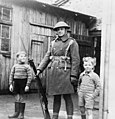
6-1940
-

7-1940
-

8-1941
-

9-1940
-

10-1943
-

11-1944
- Greek Archbishop with an advisor's girl
- Children sat with their mother in a private living room in London
- Children in Budapest
- Belgian refugees in London
- Italian postcard featuring an infant
- Boys in the British occupied Faroe Islands stood with a sentry
- Two girls with an older woman in Slovenia
- Busy playground in Balgowlah, New South Wales
- Girls saturday on a porch in Louisiana
- Children at a wartime factory nursery in Toronto, Ontario
- Children studying at a school in Cambridgeshire, England
See also [edit]
- Interwar period
- Dwelling house front during Globe War Ii
- United states habitation front during Globe War 2
- Uk home front during Earth War II
- Australian home front during World State of war Two
Notes [edit]
- ^ a b Wilcox, R. Turner: The Manner in Fashion, 1942; rev. 1958, p. 328–36
- ^ a b Wilcox, R. Turner: The Way in Fashion, 1942; rev. 1958, pp. 379–84
- ^ Flapper dresses
- ^ Shrimpton, J (2014). Way in the 1940s. Oxford: Shire Publications. p. nineteen.
- ^ a b Welters, Linda; Cunningham, Patricia, eds. (2005-03-01). Twentieth-Century American Fashion. Dress, Body, Culture. Berg Publishers. doi:10.2752/9781847882837. ISBN9781847882837.
- ^ a b c d "What Did Women Clothing in the 1940s?". Retrieved September 21, 2016.
- ^ Ewing, Elizabeth: History of 20th Century Fashion, London, 1974, p. 97, 1997 revised edition, ISBN 0-89676-219-X
- ^ a b "Hollywood Influences Style - Way, Costume, and Civilisation: Wear, Headwear, Torso Decorations, and Footwear through the Ages". www.fashionencyclopedia.com . Retrieved 2018-04-21 .
- ^ Mode : the definitive history of costume and style. Brown, Susan, 1965-, DK Publishing, Inc., Smithsonian Establishment. (1st American ed.). New York, N.Y.: DK Publishing. 2012. ISBN9780756698355. OCLC 777654556.
{{cite book}}: CS1 maint: others (link) - ^ Quoted in LaValley, "Hollywood and Seventh Avenue"
- ^ a b c d LaValley, "Hollywood and Seventh Avenue", in Hollywood and History: Costume Design in Pic
- ^ Leese, Elizabeth: Costume Design in the Movies, Dover Books, 1991, ISBN 0-486-26548-X, p. 18
- ^ a b Chung, So-Young; Cho, Kyu-Hwa (2006). "A Study on the Fashion Fashion of Hollywood Star Marlene Dietrich in 1930s". Journal of Way Concern. x: 1–fourteen.
- ^ Song, Immature-Kyoung; Lim, Immature-Ja (November 2007). "The Report on the Hollywood Film Costume of Style epitome in 1930s". Journal of the Korean Lodge of Costume. 57: 110–123.
- ^ Kim, Hyun-Jung; Cho, Kyu-Hwa (2003). "A Study o Costume and Colour Symbolism of Gone with the Wind". Journal of Style Business. 7: one–12.
- ^ a b c d e Brockman, Theory of Fashion Design, pp. forty–52
- ^ The Queen'south mother had died in June 1938.
- ^ a b c d Garland, Madge, in J. Anderson Black and Madge Garland, A History of Style, pp. 324–239
- ^ Bryant, Nancy O. "The interrelationship between decorative and structural design in Madeleine Vionnet's Work", Costume 1991, 5 25, pp. 73–88
- ^ United Press (i April 1954). "Hemline Changes Balmy Now". Tuscaloosa (Ala.) News . Retrieved 1 March 2014.
- ^ a b Tortora, P., & Eubank, K. (2005). A survey of historic costume. pp 400–450. New York: Fairchild
- ^ Marshall Field & Company, Fashions of the 60 minutes, Bound 1936, p. 2
- ^ Rationed fashion
- ^ 1930s beachwear
- ^ Spruce bathing suit
- ^ a b c Kennett, Lee (1985). For the elapsing... : the Us goes to state of war, Pearl Harbor-1942. New York: Scribner. pp. 127–129. ISBN978-0-684-18239-i.
- ^ "Nylon Stocking society". Orgsites.com. 1940-05-15. Archived from the original on 2012-08-16. Retrieved 2012-08-fifteen .
- ^ WPB "Yardstick" Archived 2009-12-26 at the Portuguese Spider web Annal and discussion of L85 regulations at Costumes.org Archived 2009-07-16 at the Portuguese Spider web Archive, retrieved 21 October 2007
- ^ a b Kemper, Rachel H: "Costume" (1992) pg. 144
- ^ Harris, Kristina, Vintage Fashions for Women, 1920s-1940s, Schiffer Publishing Ltd., 1996, p. 137.
- ^ Warren, Geoffrey (1987). Fashion Accessories Since 1500 . New York: Drama Book Publishers. pp. 146–147.
- ^ Shrimpton, Jayne (2014). Way in the 1940s. Corking Britain: Shire Publications. pp. 42–49.
- ^ "Price of Freedom: Dressing for War". The Price of Freedom: World War Ii. National Museum of American History, Behring Eye. Retrieved April four, 2016.
- ^ Kennedy, Sarah (2010). The Swimsuit: A History of Twentieth-Century Fashions . London: Carlton Books Limited. pp. 114.
- ^ Reed, Paula (2012). 50 Fashion Looks That Changed The 1950s. London: Conran Octopus. p. 34.
- ^ Boyer (1990).
- ^ Walker, Richard: The Savile Row Story, Prion, 1988, ISBN 1-85375-000-X
- ^ Due south African blazer
- ^ a b "1930s Way: Women's, Men'due south, and Children's Wearable". FamilySearch Blog. 2020-05-29. Retrieved 2021-08-04 .
- ^ Elena (2018-09-28). "3 magazines from 1930s". Vintage Sewing Machines . Retrieved 2021-08-04 .
- ^ "eight Facts about Clothes Rationing in Britain During the Second World War". Purple State of war Museums . Retrieved 2021-08-04 .
- ^ "Young slaves of fashion". The Guardian (archive). 1 July 1938. Archived from the original on 2016-07-02. Retrieved 2021-08-04 .
- ^ "1930s CHILDREN'S WEAR – Screen Archive South E". Retrieved 2021-08-04 .
References and further reading [edit]
- Arnold, Janet: Patterns of Fashion two: Englishwomen's Dresses and Their Construction c. 1860–1940, Wace 1966, Macmillan 1972. Revised metric edition, Drama Books 1977. ISBN 0-89676-027-viii
- Black, J. Anderson, and Madge Garland, A History of Manner, New York, Morrow, 1975
- Boyer, G. Bruce, Eminently Suitable, New York: W. W. Norton & Co. Inc., 1990, ISBN 978-0-393-02877-5
- Brockman, Helen, The Theory of Manner Design, New York: John Wiley and Sons, 1965 ISBN 0-471-10586-four
- Bryant, Nancy O. "The interrelationship between decorative and structural design in Madeleine Vionnet's Work", Costume 1991, 5 25, pp. 73–88
- Hawes, Elizabeth: Fashion is Spinach, New York: Random Business firm, 1938
- Hunt, Marsha: The Way We Wore: Styles of the 1930s and '40s and Our World Since Then, Fallbrook Pub. Ltd., 1993, ISBN i-882747-00-3
- LaValley, Satch: "Hollywood and Seventh Artery: The Touch on of Historical Films on Fashion", in Hollywood and History: Costume Design in Motion-picture show, Los Angeles County Museum of Art/Thames and Hudson, 1987, ISBN 0-500-01422-ane
- Laver, James: The Concise History of Costume and Fashion, Abrams, 1979.
- Leese, Elizabeth: Costume Blueprint in the Movies, Dover Books, 1991, ISBN 0-486-26548-X
- Steele, Valerie: Paris Style: A Cultural History, Oxford University Press, 1988, ISBN 0-nineteen-504465-7
- Steele, Valerie: The Corset, Yale University Press, 2001
- Walker, Richard: The Savile Row Story, Prion, 1988, ISBN ane-85375-000-Ten
- Wilcox, R. Turner: The Mode in Fashion, 1942; 2d expanded edition New York: Scribners, 1958.
External links [edit]
- 1930s Fashion History
- Chicago Woolen Mills catalog for 1937
- Fashions from the Sears Catalog, 1934
- Picture galleries of 1930s fashions (United kingdom)
- "1930s - 20th Century Style Drawing and Illustration". Fashion, Jewellery & Accessories. Victoria and Albert Museum. Archived from the original on 2011-08-02. Retrieved 2011-04-03 .
- 1930s Way Plates of men, women, and children'south fashion from The Metropolitan Museum of Art Libraries
0 Response to "Doughboys 1930 Pictures of Fashion From the Decade 1930"
Post a Comment